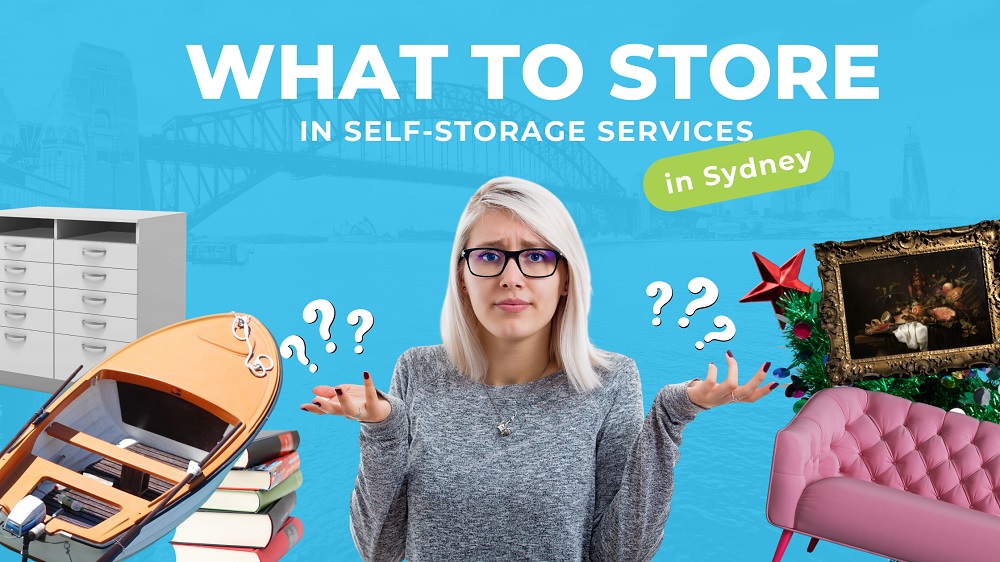Are you running out of space in your home or office? Do you have belongings that are taking up too much space, but you can’t bear to part with? If so, self-storage services might be the perfect solution for you. And if you’re in Sydney, you’re in luck – Macy’s Mobile Self-Storage is here to help!
Our state-of-the-art self-storage services are designed to make your life easier. Whether you’re moving, renovating your home or office, or just need some extra space, we’ve got you covered. But what exactly can you store in our self-storage units? Here are some ideas!
Common Items Stored in Self-Storage
Self-storage units are a convenient way to store a variety of items, ranging from furniture and personal belongings to business documents and seasonal decorations. Below are some common items that are typically stored in self-storage units:
1. Furniture
Self-storage is an ideal solution for storing furniture that you don’t need daily. This can include items such as spare couches, chairs, tables, and bed frames. Storing them in a self-storage unit can help free up space in your home or office.
2. Clothing and Personal Items
Clothing and personal items such as shoes, bags, and accessories can take up a lot of space in your home. Storing these items in a self-storage unit can help keep your home clutter-free and organised.
3. Business Documents and Inventory
Self-storage units are also ideal for storing business documents and inventory. This includes important files, documents, and excess inventory that may not fit in your office or warehouse.
4. Vehicles
Vehicles such as cars, boats, and RVs can be stored in self-storage units. This can help protect them from weather elements and theft.
5. Electronics and Appliances
Electronics such as TVs, computers, and gaming consoles, as well as appliances such as refrigerators and washing machines, can also be stored in self-storage units. This can help protect them from damage during a move or renovation.
6. Artwork and Collectibles
Artwork and collectibles such as paintings, sculptures, and antiques can be stored in a self-storage unit to help protect them from damage or theft. Climate-controlled units are recommended for storing delicate items.
7. Seasonal Decorations
Seasonal decorations such as Christmas trees, Halloween decorations and outdoor lights can take up a lot of space in your home when not in use. Storing them in a self-storage unit can help keep your home organised and clutter-free.
By storing these common items in self-storage units, you can free up space in your home or office and keep your belongings safe and secure.
Types of Storage Units Suitable for Specific Items
When it comes to storage units, there are different types available that can accommodate specific items based on their storage needs. Below are seven types of storage units that are suitable for specific items:
Climate-Controlled Units
Climate-controlled units are ideal for storing items that are sensitive to temperature and humidity changes, such as wooden furniture, electronics, and artwork. These units are kept at a constant temperature and humidity level, which helps prevent damage to your belongings.
Drive-Up Units
Drive-up units are a convenient option for items that require easy access, such as a vehicle, tools, or equipment. These units are located on the ground floor, so you can drive up to them and load or unload your items directly from your vehicle.
Small Units
Small units are perfect for storing items that are compact and do not require a lot of space, such as boxes, books, and small furniture. These units are typically less expensive than larger units, making them a cost-effective storage solution.
Outdoor Units
Outdoor units are suitable for items that are not sensitive to weather changes, such as sports equipment, lawn furniture, and outdoor tools. These units are often less expensive than climate-controlled units and can be a good option for those on a budget.
Pallet Storage Units
Pallet storage units are designed for businesses that need to store items on pallets, such as inventory, supplies, and equipment. These units are typically located on the ground floor and have high ceilings, making them ideal for storing large, bulky items.
Wine Storage Units
Wine storage units are specifically designed to store wine bottles in a climate-controlled environment. These units can help protect your wine collection from temperature and humidity fluctuations, which can affect the quality of the wine.
Vehicle Storage Units
Vehicle storage units are ideal for storing unused vehicles, such as cars, boats, and RVs. These units can be indoor or outdoor and can provide protection from weather elements and theft.
When choosing a storage unit, it’s important to consider the type of items you will be storing and their specific storage needs. By selecting the right storage unit, you can help ensure that your belongings remain safe, secure, and in good condition.
Tips on Organising Items in Self-Storage
Organising your items in a self-storage unit can help maximise the space and keep your belongings safe and accessible. Below are seven tips on how to organise items in self-storage:
1. Make an Inventory
Before you start packing your items, make an inventory of everything you plan to store. This will help you keep track of your belongings and ensure that you don’t forget anything when it’s time to retrieve them.
2. Categorise Items
Categorising your items can help make it easier to find what you need later on. For example, you could group your items by room, season, or use.
3. Use Shelving and Pallets
Using shelving and pallets can help maximise the space in your storage unit and keep your items off the floor. This can also help protect your items from moisture and pests.
4. Label Boxes and Containers
Labelling your boxes and containers can help you quickly identify what’s inside without having to open them. Be sure to label the boxes on all sides for easy visibility.
5. Use Protective Coverings
Using protective coverings such as plastic wrap, blankets or bubble wrap can help protect your items from dust, moisture, and scratches.
6. Leave Space for Access
When packing your storage unit, be sure to leave some space for access. This will make it easier for you to retrieve items later on without having to move everything around.
7. Avoid Overpacking
Overpacking boxes and containers can make them heavy and difficult to move. Be sure to pack items loosely and avoid packing too many heavy items in one box.
By following these tips, you can help keep your self-storage unit organised and your belongings safe and accessible.
How to Use Self-Storage Services in Sydney
Self-storage services in Sydney are a convenient way to store your belongings, whether you’re moving, downsizing, or simply need extra space. Here are some tips for packing and preparing your items for self-storage:
1. Clean and Dry Items
Before storing your items, make sure they are clean and dry. This will help prevent mould and mildew from forming and keep your items in good condition.
2. Disassemble Furniture
Disassembling furniture can help save space in your storage unit and make it easier to move your items in and out. Be sure to label each piece and keep all screws and bolts in a labelled bag.
3. Use Appropriate Packing Materials
Use appropriate packing materials such as boxes, packing paper, bubble wrap, and packing tap to protect your items during transport and storage.
4. Label Boxes and Containers
Label all boxes and containers with a description of the contents and the room they came from. This will help you find what you need later without opening every box.
5. Use Plastic Covers
Use plastic covers to protect your items from dust and moisture. This is especially important for mattresses, sofas, and other upholstered items.
6. Store Items off the Ground
Storing items off the ground can help protect them from moisture and pests. Use pallets, shelves, or other storage units to keep your items off the ground.
7. Leave Space for Air Circulation
Leave some space between your items and the walls of the storage unit to allow air circulation. This can help prevent mould and mildew from forming.
8. Securely Pack and Store Hazardous Items
If you need to store hazardous items such as chemicals, paint, or gasoline, be sure to securely pack and label them. Store them in a separate, well-ventilated area away from other items.
By following these tips, you can ensure that your items are safely and securely stored in a self-storage unit.
How to Move Items Into and Out of Storage
Moving items into and out of storage can be a daunting task, but with the right preparation and tools, it can be a breeze. Here are some tips to ensure a smooth move:
1. Plan Ahead
Make a list of everything you need to move and organise them by priority. Determine the size of the storage unit you need and make sure it’s available when you need it.
2. Rent a Moving Truck
If you have a lot of items to move, renting a moving truck can make the process much easier. Make sure the truck is the appropriate size for your needs and reserve it in advance.
3. Use Proper Lifting Techniques
Lifting heavy items can be dangerous, so make sure to use proper lifting techniques to avoid injury. Bend your knees and keep your back straight when lifting and use your legs to lift the weight.
4. Protect Fragile Items
Wrap fragile items in bubble wrap or newspaper to prevent them from breaking during the move. Use packing peanuts or foam to fill any gaps in boxes.
5. Use Dollies and Hand Trucks
These tools can make moving heavy items much easier. Use a dooly or hand truck to move boxes and furniture.
6. Use Furniture Covers
Protect your furniture from scratches and damage by using furniture covers. These covers can be purchased at most moving supply stores or rented from the storage facility.
7. Stack Boxes and Containers
Stack boxes and containers in a stable and secure manner. Place heavier items on the bottom and lighter items on top.
8. Label Boxes and Containers
Label each box and container with its contents, so you can know exactly where everything is when you need it.
9. Use a Ramp or Elevator
If you’re moving items into or out of a storage unit on an upper level, use a ramp or elevator to make the process easier and safer.
By following these tips, you can move your items into and out of storage with ease and confidence.
Maintenance and Upkeep of Storage Items
When storing items in a storage unit, it’s important to maintain and upkeep them to ensure they remain in good condition. Here are some tips for maintaining and keeping your stored items in good condition:
Check on Stored Items Regularly
It’s important to check your stored items regularly to ensure they are in good condition. Check for any signs of damage, such as moisture, mould, or pests. By catching any issues early, you can prevent them from becoming bigger problems.
Keep the Storage Unit Clean
Keeping your storage unit clean is essential for maintaining the condition of your stored items. Sweep or vacuum the unit regularly to remove dust, dirt, and debris. Wipe down any surfaces with a damp cloth to remove any stains or spills.
Control Temperature and Humidity
Temperature and humidity can have a significant impact on the condition of your stored items. To prevent damage from fluctuations in temperature or humidity, choose a climate-controlled storage unit. This will maintain a consistent temperature and humidity level, which is especially important for items such as electronics, artworks, and antiques.
Rotate Items
To prevent damage from prolonged storage, it’s important to rotate your stored items periodically. This can prevent damage from prolonged pressure or exposure to light. For example, if you’re storing books or records, rotate them periodically to prevent them from becoming warped or damaged.
Store Items Properly
Proper storage is essential for maintaining the condition of your stored items. Use appropriate packing materials such as boxes, bubble wrap, and packing peanuts to protect your items. Store items off the ground, using shelves or pallets to prevent moisture damage. Avoid storing items in plastic bags, which can trap moisture and lead to mould growth.
Use Proper Lighting
Proper lighting is important for maintaining the condition of your stored items. Avoid using harsh fluorescent lighting, which can damage items such as artwork or photographs. Instead, use soft lighting such as incandescent bulbs or natural light.
Store hazardous Materials Safely
If you’re storing hazardous materials such as gasoline, pesticides, or cleaning chemicals, it’s important to store them safely. Choose a designated area for hazardous materials, away from other items. Store them in sealed, labelled containers and follow all safety guidelines for storage and handling.
By following these tips, you can maintain and upkeep your stored items, ensuring they remain in good condition for years to come.
Keep Your Belongings Safe and Secure with Macy’s Mobile Self-Storage Services
Are you running out of space at home or in the office? Do you need a safe and secure place to store your belongings? Macy’s Mobile Self-Storage is here to help! Our innovative storage solutions are designed to make storage easy, convenient, and stress-free.
At Macy’s, our storage units are available in different sizes to meet your specific needs, and our mobile service makes it easy to access your belongings whenever you need them.
In addition to our convenient storage solutions, we also offer temperature-controlled units to help protect your belongings from extreme temperatures and humidity. Our storage facility is secure, with 24/7 surveillance and limited access to ensure the safety of your items.
Choose Macy’s Mobile Self-Storage for all your storage needs. Contact us today via our website or call us on 1300 40 90 69 to learn more about our services and schedule your storage unit delivery.

 Call us
Call us 




